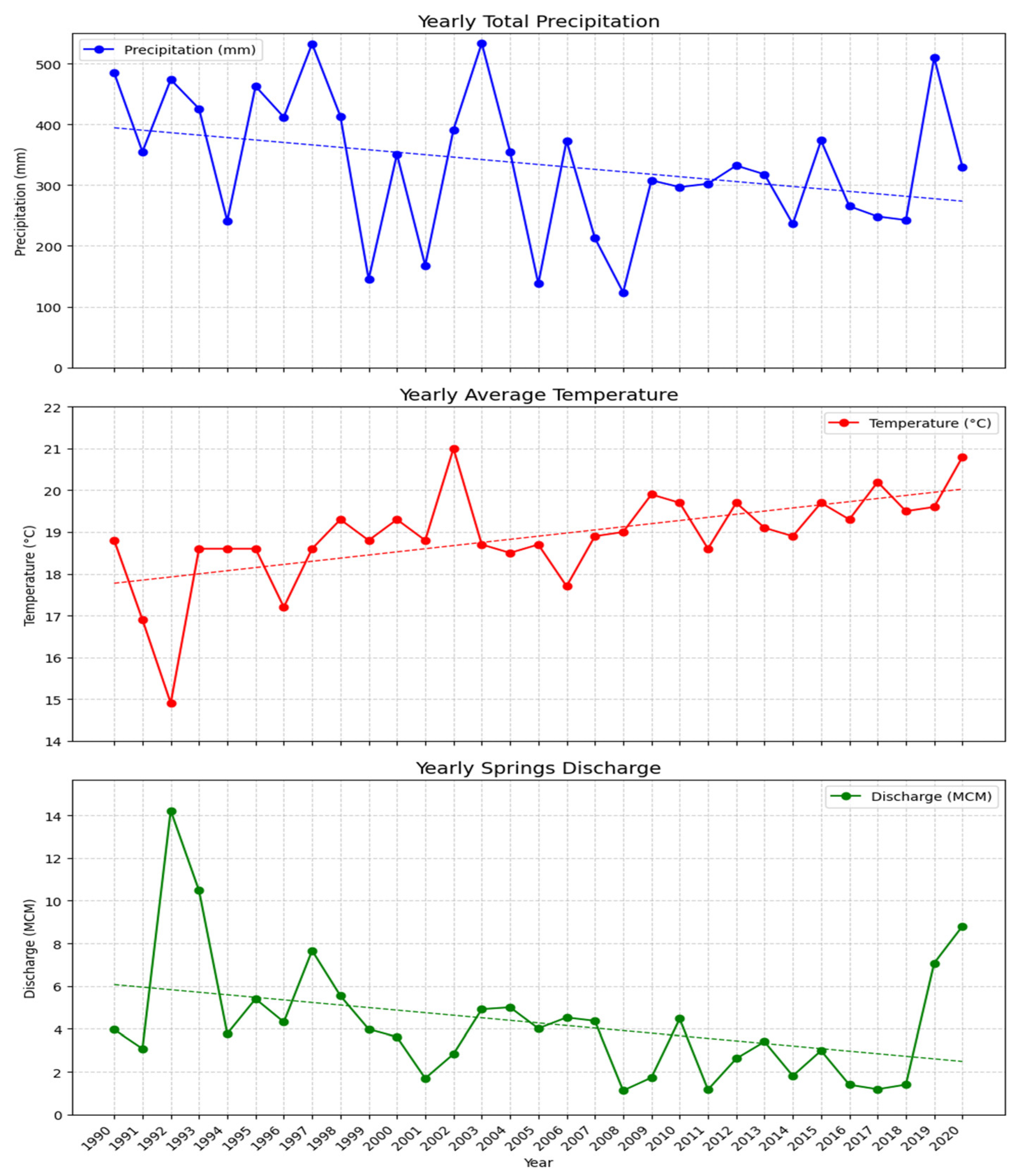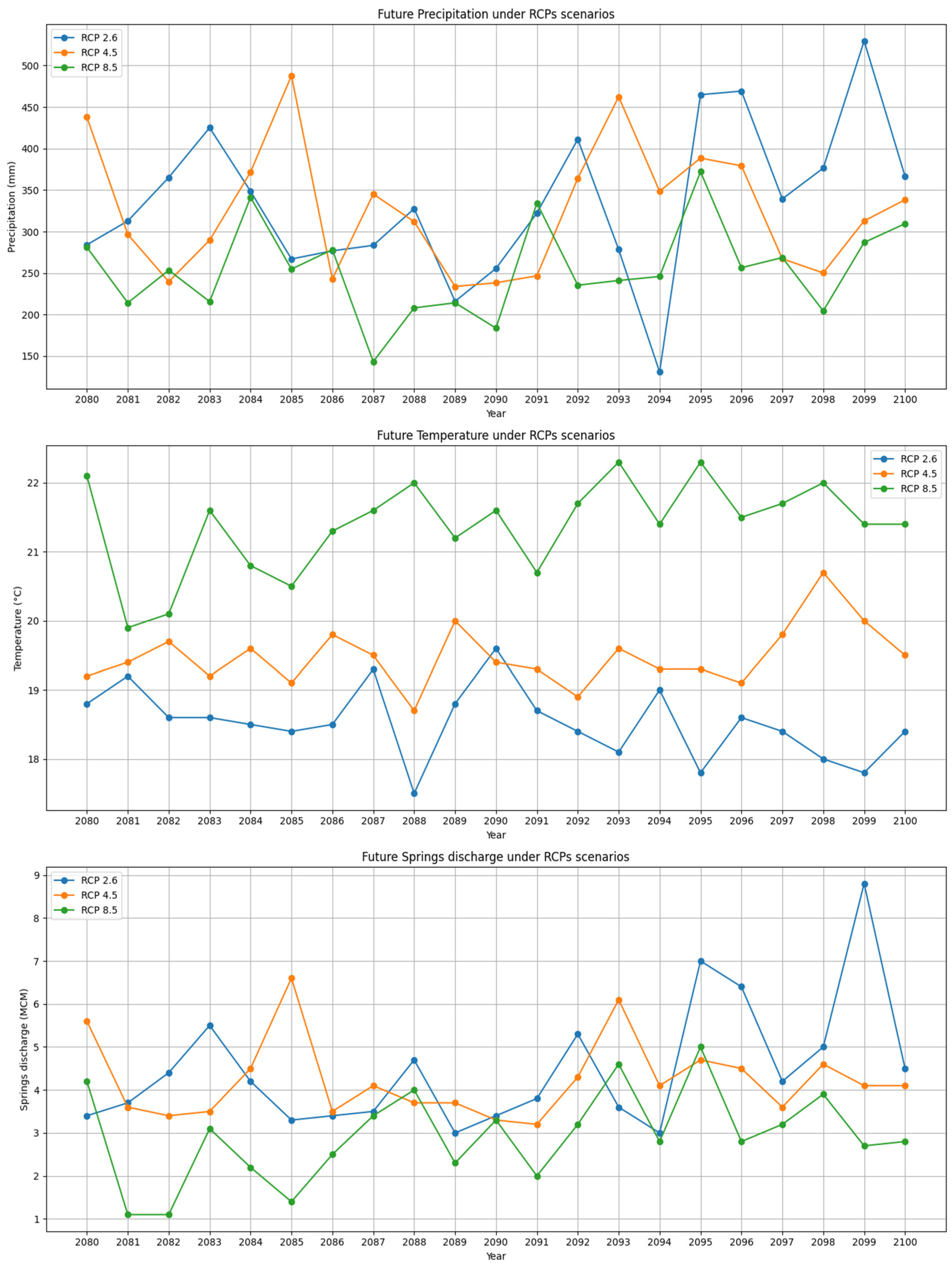Impacts of Climate Change on Groundwater in the Al-Badan Sub-Catchment, Palestine: Analyzing Historical Data and Future Scenarios
Abstract
:1. Introduction
- Secondly, it quantitatively examines the statistical relationship between precipitation, temperature, and spring discharge using multiple correlation analysis, which is effective for understanding hydrological relationships. [21,22]. The residual analysis of the regression model will also be conducted to assess the model’s accuracy, and this correlation will be used for predicting future spring discharge.
- Finally, the study integrates climate scenarios based on RCPs to predict future changes in precipitation and temperature and their impact on spring discharge for the periods 2040–2060 and 2080–2100. Climate scenarios based on Representative Concentration Pathways (RCPs) are used to model future changes in precipitation, temperature and their impact on water resources [23,24]. These objectives aim to understand Al-Badan’s climate and water patterns for sustainable management and adaptation.
2. Materials and Methods
2.1. Study Area
2.2. Data
2.3. Trend Analysis
2.4. Correlation Analysis
2.5. Climate Change Scenarios for the Period 2040–2060 and 2080–2100
3. Results
3.1. Trend Analysis
3.2. Correlation Analysis
3.3. Climate Change Scenarios for the Period 2040–2060 and 2080–2100
4. Discussion
5. Conclusions
Author Contributions
Funding
Data Availability Statement
Acknowledgments
Conflicts of Interest
References
- Faquseh, H.; Grossi, G. The effect of climate change on groundwater resources availability: A case study in the city of Brescia, Northern Italy. Sustain. Water Resour. Manag. 2023, 9, 113. [Google Scholar] [CrossRef]
- El-Fadel, M.; Zeinati, M.; Jamali, D. Water Resources in Lebanon: Characterization, Water Balance and Constraints. Int. J. Water Resour. Dev. 2000, 16, 615–638. [Google Scholar] [CrossRef]
- Brekke, L.D.; Kiang, J.E.; Olsen, J.R.; Pulwarty, R.S.; Raff, D.A.; Turnipseed, D.P.; Webb, R.S.; White, K.D. Climate Change and Water Resources Management: A Federal Perspective; Circular; U.S. Geological Survey: Reston, VA, USA, 2009. [CrossRef]
- Giorgi, F.; Lionello, P. Climate Change Projections for the Mediterranean Region. Glob. Planet. Chang. 2008, 63, 90–104. [Google Scholar] [CrossRef]
- El-Fadel, M.; Bou-Zeid, E. Climate Change and Water Resources in the Middle East: Vulnerability, Socio-Economic Impacts and Adaptation. In Climate Change in the Mediterranean; Edward Elgar Publishing: Cheltenham, UK, 2003. [Google Scholar] [CrossRef]
- Shadeed, S.M.; Judeh, T.G.; Almasri, M.N. Developing GIS-Based Water Poverty and Rainwater Harvesting Suitability Maps for Domestic Use in the Dead Sea Region (West Bank, Palestine). Hydrol. Earth Syst. Sci. 2019, 23, 1581–1592. [Google Scholar] [CrossRef]
- UNEP. Division for Communications and Strategic Partnerships. Report of the State of World Population. 2021. Available online: https://wedocs.unep.org/handle/20.500.11822/32692 (accessed on 1 October 2024).
- UNEP. State of Environment and Outlook Report for the Occupied Palestinian Territory. 2020. Available online: https://wedocs.unep.org/20.500.11822/32268 (accessed on 1 October 2024).
- ENEP. Division for Environmental and Natural Resources. Water Availability and Groundwater Depletion in the West Bank. 2020. Available online: https://www.unep.org/publications-data (accessed on 1 October 2024).
- Abboushi, A.M.; Almasri, M.N.; Shadeed, S.M. A Preliminary Investigation of Wadi–Aquifer Interaction in the Semi-Arid Watershed of Faria, Palestine Using Tracer-Based Methodology. Environ. Earth Sci. 2014, 73, 7861–7872. [Google Scholar] [CrossRef]
- Wasimi, S.A. Climate Change in the Middle East and North Africa (MENA) Region and Implications for Water Resources Project Planning and Management. Int. J. Clim. Chang. Strateg. Manag. 2010, 2, 297–320. [Google Scholar] [CrossRef]
- Mizyed, N. Climate Change Challenges to Groundwater Resources: Palestine as a Case Study. J. Water Resour. Prot. 2018, 10, 215–229. [Google Scholar] [CrossRef]
- Kosasih, E.A.; Zikri, A.; Dzaky, M.I. Water Vapor Desorption from Silica Gel in a Combined Drying and Double-Condenser Compression Refrigeration System. Heliyon 2022, 8, e09757. [Google Scholar] [CrossRef]
- Shadeed, S. Up to Date Hydrological Modeling in Arid and Semiarid Catchment: The Case of Faria Catchment, West Bank, Palestine. Ph.D. Thesis, Freiberg University, Freiberg, Germany, 2008. [Google Scholar]
- Saleh, Y. Artificial Groundwater Recharge in Faria Catchment: A Hydrogeological Study. Master’s Thesis, An-Najah National University, Nablus, Palestine, 2009. [Google Scholar]
- Shadeed, S. Spatio-Temporal Drought Analysis in Arid and Semi-Arid Regions: A Case Study from Palestine. Arab. J. Sci. Eng. 2012, 38, 2303–2313. [Google Scholar] [CrossRef]
- Shadeed, S.; Lange, J. Rainwater Harvesting to Alleviate Water Scarcity in Dry Conditions: A Case Study in Faria Catchment, Palestine. Water Sci. Eng. 2010, 3, 132–143. [Google Scholar]
- Shaheen, H.; Jayyousi, A.; Shadeed, S.; Jarrar, A. Hydrograph Estimation in Semiarid Regions Using GIS Supported GIUH Model. In Proceedings of the Ninth International Water Technology Conference (IWTC9), Sharm El-Sheikh, Egypt, 17–20 March 2005; p. 371. [Google Scholar]
- Faquseh, H.; Grossi, G. Trend Analysis of Precipitation, Temperature and Snow Water Equivalent in Lombardy Region, Northern Italy. Sustain. Water Resour. Manag. 2024, 10, 18. [Google Scholar] [CrossRef]
- Ciampittiello, M.; Marchetto, A.; Boggero, A. Water Resources Management Under Climate Change: A Review. Preprints 2023, 16, 3590. [Google Scholar] [CrossRef]
- Adji, T.N.; Bahtiar, I.Y. Rainfall–Discharge Relationship and Karst Flow Components Analysis for Karst Aquifer Characterization in Petoyan Spring, Java, Indonesia. Environ. Earth Sci. 2016, 75, 9. [Google Scholar] [CrossRef]
- Kumar, C.P.; Singh, S. Climate Change Effects on Groundwater Resources. Octa J. Environ. Res. 2015, 3, 264–271. [Google Scholar]
- Meinshausen, M.; Smith, S.J.; Calvin, K.; Daniel, J.S.; Kainuma, M.L.; Lamarque, J.F.; Matsumoto, K.; Montzka, S.A.; Raper, S.C.; Riahi, K.; et al. The RCP Greenhouse Gas Concentrations and Their Extensions from 1765 to 2300. Clim. Chang. 2011, 109, 213–241. [Google Scholar] [CrossRef]
- Li, H.; Sheffield, J.; Wood, E.F. Bias Correction of Monthly Precipitation and Temperature Fields from Intergovernmental Panel on Climate Change AR4 Models Using Equidistant Quantile Matching. J. Geophys. Res. 2010, 115, D10101. [Google Scholar] [CrossRef]
- PCBS. Population, Housing and Establishments Census 2017: Census Final Results—Detailed Report—Palestine. Ramallah—Palestine. 2018. Available online: https://www.pcbs.gov.ps/pcbs_2012/Publications.aspx (accessed on 9 September 2023).
- Shadeed, S.; Shaheen, H.; Jayyousi, A. GIS-Based KW-GIUH Hydrological Model of Semiarid Catchments: The Case of Faria Catchment, Palestine. Arab. J. Sci. Eng. 2006, 32, 3–16. [Google Scholar]
- PMD. Available online: https://www.pmd.ps/en (accessed on 9 September 2023).
- PWA. Palestinian Water Authority. Available online: https://www.pwa.ps/english.aspx (accessed on 9 September 2023).
- ESGF. Cordex. Available online: https://esg-dn1.nsc.liu.se/search/cordex/ (accessed on 9 September 2023).
- Aditya, F.; Gusmayanti, E.; Sudrajat, J. Rainfall Trend Analysis Using Mann-Kendall and Sen’s Slope Estimator Test in West Kalimantan. IOP Conf. Ser. Earth Environ. Sci. 2021, 893, 012006. [Google Scholar] [CrossRef]
- Xing, L.; Huang, L.; Chi, G.; Yang, L.; Li, C.; Hou, X. A Dynamic Study of a Karst Spring Based on Wavelet Analysis and the Mann-Kendall Trend Test. Water 2018, 10, 698. [Google Scholar] [CrossRef]
- Kendall, M.G. Rank Correlation Methods; Griffin: London, UK, 1975. [Google Scholar]
- Mann, H.B. Nonparametric Test against the Trend. Econometrica 1945, 13, 245–259. [Google Scholar] [CrossRef]
- García-Ruiz, J.M.; Lopez-Moreno, J.I.; Vicente-Serrano, S.M.; Lasanta-Martinez, T.; Begueria, S. Mediterranean Water Resources in a Global Change Scenario. Earth Sci. Rev. 2011, 105, 121–139. [Google Scholar] [CrossRef]
- Fiorillo, F.; Doglioni, A. The Relation Between Karst Spring Discharge and Rainfall by Cross-Correlation Analysis (Campania, Southern Italy). Hydrogeol. J. 2010, 18, 1881–1895. [Google Scholar] [CrossRef]
- Harbaugh, A.W.; McDonald, M.G. User’s Documentation for MODFLOW-96, an Update to the U.S. Geological Survey Modular Finite Difference Ground Water Flow Model; U.S. Geological Survey: Reston, VA, USA, 1996. [CrossRef]
- Karl, T.R.; Knight, R.W. Secular Trends of Precipitation Amount, Frequency, and Intensity in the United States. Bull. Am. Meteorol. Soc. 1998, 79, 231–241. [Google Scholar] [CrossRef]
- IPCC. Climate Change 2013: The Physical Science Basis. Contribution of Working Group I to the Fifth Assessment Report of the Intergovernmental Panel on Climate Change; Stocker, T.F., Qin, D., Plattner, G.K., Tignor, M., Allen, S.K., Boschung, J., Nauels, A., Xia, Y., Bex, V., Midgley, P.M., Eds.; Cambridge University Press: Cambridge, UK; New York, NY, USA, 2013; 1535p. [Google Scholar] [CrossRef]
- Annisa, H.N.; Nugroho, B.D. Analysis and Projections of Rainfall Using Representative Concentration Pathways (RCPs) Scenarios in Sleman Yogyakarta. IOP Conf. Ser. Earth Environ. Sci. 2021, 653, 012099. [Google Scholar] [CrossRef]
- Andrade, C.W.L.; Montenegro, S.M.G.L.; Montenegro, A.A.A.; Lima, J.R.d.S.; Srinivasan, R.; Jones, C.A. Climate Change Impact Assessment on Water Resources Under RCP Scenarios: A Case Study in Mundaú River Basin, Northeastern Brazil. Int. J. Climatol. 2020, 41, E1045–E1061. [Google Scholar] [CrossRef]
- Lelieveld, J.; Hadjinicolaou, P.; Kostopoulou, E.; Chenoweth, J.; El Maayar, M.; Giannakopoulos, C.; Hannides, C.; Lange, M.A.; Tanarhte, M.; Tyrlis, E.; et al. Climate Change and Impacts in the Eastern Mediterranean and the Middle East. Clim. Chang. 2012, 114, 667–687. [Google Scholar] [CrossRef]
- Haddad, M. Irrigation Adaptation to Changing Water Supply: Palestine as a Case Study. Impacts Glob. Clim. Chang. 2005, 23, 1–12. [Google Scholar] [CrossRef]
- Alpert, P.; Ben-Gai, T.; Baharad, A.; Benjamini, Y.; Yekutieli, D.; Colacino, M.; Diodato, L.; Ramis, C.; Homar, V.; Romero, R.; et al. The Paradoxical Increase of Mediterranean Extreme Daily Rainfall in Spite of Decrease in Total Values. Geophys. Res. Lett. 2002, 29, 31-1–31-4. [Google Scholar] [CrossRef]
- Toonen, W.H.J.; Middelkoop, H.; Konijnendijk, T.Y.M.; Macklin, M.G.; Cohen, K.M. The Influence of Hydroclimatic Variability on Flood Frequency in the Lower Rhine. Earth Surf. Process. Landf. 2016, 41, 1266–1275. [Google Scholar] [CrossRef]
- Jones, R.N.; Chiew, F.H.S.; Boughton, W.C.; Zhang, L. Estimating the Sensitivity of Mean Annual Runoff to Climate Change Using Selected Hydrological Models. Adv. Water Resour. 2006, 29, 1419–1429. [Google Scholar] [CrossRef]






| Parameter | Average Yearly Value | Mann-Kendall Test Z-Statistic | p-Value | Sen’s Slope Estimate | Significance |
|---|---|---|---|---|---|
| Precipitation | 334.12 mm | −2.01 | 0.045 | −5.5 mm/year | Significant decrease |
| Temperature | 18.9 °C | 3.858 | 0.0001 | 0.061325 °C/year | Significant increase |
| Springs Discharge | 4.3 MCM | −2.21 | 0.027 | −110,920 m3/year | Significant decrease |
Disclaimer/Publisher’s Note: The statements, opinions and data contained in all publications are solely those of the individual author(s) and contributor(s) and not of MDPI and/or the editor(s). MDPI and/or the editor(s) disclaim responsibility for any injury to people or property resulting from any ideas, methods, instructions or products referred to in the content. |
© 2024 by the authors. Licensee MDPI, Basel, Switzerland. This article is an open access article distributed under the terms and conditions of the Creative Commons Attribution (CC BY) license (https://creativecommons.org/licenses/by/4.0/).
Share and Cite
Faquseh, H.; Shadeed, S.; Grossi, G. Impacts of Climate Change on Groundwater in the Al-Badan Sub-Catchment, Palestine: Analyzing Historical Data and Future Scenarios. Hydrology 2024, 11, 169. https://doi.org/10.3390/hydrology11100169
Faquseh H, Shadeed S, Grossi G. Impacts of Climate Change on Groundwater in the Al-Badan Sub-Catchment, Palestine: Analyzing Historical Data and Future Scenarios. Hydrology. 2024; 11(10):169. https://doi.org/10.3390/hydrology11100169
Chicago/Turabian StyleFaquseh, Hamzah, Sameer Shadeed, and Giovanna Grossi. 2024. "Impacts of Climate Change on Groundwater in the Al-Badan Sub-Catchment, Palestine: Analyzing Historical Data and Future Scenarios" Hydrology 11, no. 10: 169. https://doi.org/10.3390/hydrology11100169
APA StyleFaquseh, H., Shadeed, S., & Grossi, G. (2024). Impacts of Climate Change on Groundwater in the Al-Badan Sub-Catchment, Palestine: Analyzing Historical Data and Future Scenarios. Hydrology, 11(10), 169. https://doi.org/10.3390/hydrology11100169








